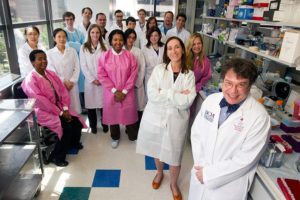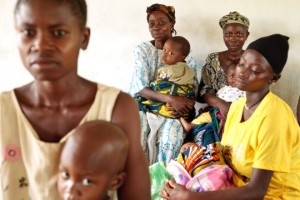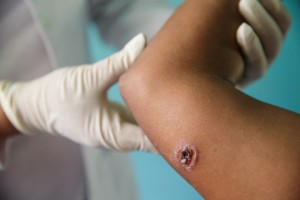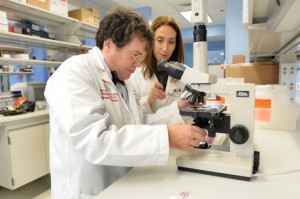A First Glimpse of the “Armadillo’s Ears”
By Peter Hotez
Recent testimony to the House Committee on Foreign Affairs hints at more to come on the problem of neglected tropical diseases and poverty in Texas.
The National School of Tropical Medicine, launched at Baylor College of Medicine in 2011, was established to offer a potent North American colleague to the century-old British tropical medicine schools in London and Liverpool and tropical disease institutes in Amsterdam, Antwerp, Basel, Hamburg, and elsewhere in Europe.

The Sabin Vaccine Institute and Texas Children’s Hospital Center for Vaccine Development team at National School of Tropical Medicine, Baylor College of Medicine.
An essential cornerstone of the National School is translational research and development, with several core faculty members actively engaged in developing new diagnostics and vaccines for the 17 major diseases of poverty known as the neglected tropical diseases (NTDs). The NTDs represent a group of parasitic and related infections that actually cause poverty because of their long-term and disabling effects on childhood cognition and physical fitness and development, adult productive capacity, and the health of girls and women. They are the most common afflictions of the extremely poor in developing countries.

Health center in Sierra Leone. Photo courtesy of Olivier Asselin.
To jumpstart the National School’s translational R&D activities, we brought to Houston the product development partnership (PDP) of the Sabin Vaccine Institute. PDPs are non-profit organizations that use industry practices in order to make new drugs, diagnostics, vaccines, insecticides, or other products needed for the control and elimination of major global health problems, such as HIV/AIDS, tuberculosis, malaria, childhood respiratory and diarrheal diseases, and the NTDs. Sabin’s PDP emphasizes vaccines for NTDs including hookworm infection, schistosomiasis, Chagas disease, leishmaniasis, and selected viral infections such as arbovirus infections and SARS. The human hookworm vaccine is in phase 1 trials, while the schistosomiasis vaccine is expected to enter clinical testing very soon.

Cutanaeous Leishmaniasis in Honduras.
In 2011, the Sabin Vaccine Institute PDP moved into new laboratories at Baylor’s affiliated institution, Texas Children’s Hospital, thereby becoming one of the few PDPs—the Sabin Vaccine Institute and Texas Children’s Hospital Center for Vaccine Development—embedded in an academic health center. In parallel, an educational program was created so that (just like its United Kingdom counterparts) the National School offers diplomas in tropical medicine for physicians, physicians-assistants, and medical students and will soon start a new summer tropical medicine institute to accommodate growing undergraduate interest in global health.

Sabin Vaccine Institute and Texas Children’s Hospital Center for Vaccine Development, National School of Tropical Medicine, Baylor College of Medicine.
Shortly after the launch of the National School, the scientists and faculty identified an astonishing level of disease and poverty right here in Texas and even in the poorer parts of Houston. We found that many individuals are afflicted with a variety of parasitic NTDs such as Chagas disease, cysticercosis, leishmaniasis, and even arbovirus infections including dengue and West Nile virus infection. Unexpectedly, transmission of some NTDs occurs in Texas and in Houston, especially among impoverished populations and people of color, as well as several animal reservoirs (including armadillos that transmit leprosy, for example). The key point is that whereas many assumed that NTDs are linked to immigrant populations coming in from Mexico and Central America, a more accurate depiction includes evidence for a previously hidden transmission of these diseases. Thus, unlike the European tropical medicine schools and institutes, the National School is combating NTDs in our own backyard. Accordingly, we have established one of the first comprehensive clinics in the United States devoted specifically to the care of people with NTDs acquired locally. It is located at the Texas Medical Center and home to a talented cadre of clinical and molecular epidemiologists to investigate the extent of the problem here in our own state. Moreover, we are now scaling up efforts to combat NTDs in Texas by developing new diagnostics and vaccines.
These activities were the subject of my recent testimony to a House Subcommittee on Africa, Global Health, Global Human Rights, and International Organizations,1 one of the components of the House Committee on Foreign Affairs.
We are at the beginning—the National School and its PDP and clinic are positioned to combat an indigenous NTD disease burden through a multidimensional approach that incorporates R&D, education, and clinical activities. Public policy is the fourth component of the National School, and in a recent June publication in PLOS Neglected Tropical Diseases, scientists from the National School collaborated with several other Texas institutions to advance a concept known as the “ears of the armadillo.”2 It is the disease equivalent of the “tip of the iceberg” idea and borrows from the “ears of the hippopotamus” (mostly submerged in the river) metaphor sometimes used to refer to the undetected malaria disease burden in sub-Saharan Africa. According to the ears of the armadillo, we have a hint that there is a lot of tropical disease and pathology among the poor in Houston and in Texas, but we need to work aggressively to understand its full extent and the basis for its links to extreme poverty.
Today, Texas may have more people living below the poverty line than any other state. An unfolding scenario of NTDs linked to our own indigenous poverty will occupy the National School for years to come.
Peter Hotez, M.D., Ph.D., was inducted into TAMEST in 2011. He is the founding dean of the National School of Tropical Medicine at Baylor College of Medicine where he also serves as president and director of the Sabin Vaccine Institute and Texas Children’s Hospital Center for Vaccine Development and Baker Institute Fellow in Disease and Poverty at Rice University. His book, Forgotten People, Forgotten Diseases (ASM Press), was released this spring.
1. http://www.globalpost.com/dispatches/globalpost-blogs/global-pulse/calling-attention-tropical-diseases-capitol-hill
2. Andrus J, Bottazzi ME, Chow J, Goraleski KA, Fisher-Hoch S, Lambuth JK, Lee BY, Margolis H, McCormick J, Melby P, Murray KO, Rico-Hesse R, Valenzuela JG, Hotez PJ. Ears of the armadillo: global health research and neglected diseases in Texas. PLOS Neglected Tropical Diseases 7 (6): e2021.

